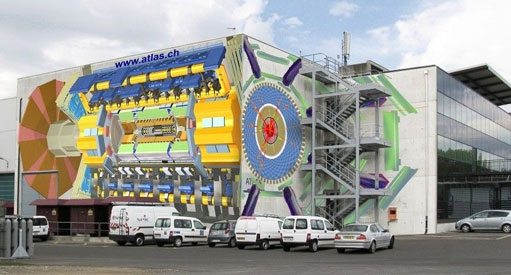 Fonte: ATLAS e-News
Fonte: ATLAS e-News----------------------------------
If you’ve been on shift over the last few weeks, you can’t have missed the burst of colour that has appeared on the side of the ATLAS building at Point 1. Artist Josef Kristofoletti arrived in town last month and his work on the first stage of the ATLAS mural is well underway.Walking over to Point 1, you’ll probably smell Josef’s creation before you see it. Round the corner of building 3182 though, and the wall behind the fire escape staircase is suddenly shouting through the heady haze of solvents about the superstructure assembled 100 metres below. The stylised image of a vertical cross section of the detector, with the beam pipe at the centre, forms the first part of the image chosen by ATLAS collaborators by vote at the end of September.
Following the public reaction to another mural that he painted of ATLAS – for the Redux Contemporary Art Center in South Carolina – Josef was invited to visit the real thing, and to come up with some ideas for how to brighten up the bland monolith at Point 1 that belies the exciting events occurring beneath.Coming face-to-face with the subject of his previous work was an “awesome experience” according to the artist. “You get that feeling, you know, whatever you want to call it… The sublime,” he muses. “You just look at certain things and think, ‘wow, how are human beings able to do something so huge?’ And that’s certainly the feeling I got from ATLAS. How is it really possible? It’s like a miracle that people are able to assemble something so complex.”Inspired, he got to work and came up with 20 initial designs for the building. “To do it on this scale really speaks more to that experience [of awe],” he says. After a panel whittled down the designs to just two, the final decision was thrown open to the Collaboration. The winning design takes in two of building 3162's huge walls, the second of which will get the artistic treatment after the winter.“Right now, I’m trying to work fast to stay ahead of the weather. I’m pushing a lot, working a lot more than I normally would be,” Josef explains, pulling spraycans from inside his boiler suit. He keeps them there to ensure the cold October weather doesn’t affect the consistency of the paint when it goes on. When the rain isn’t falling, he can be found halfway up the building on a cherry picker, kitted out in hardhat, gas mask, and safety harnesses, and layering bright colours onto the surface of the wall.“I’m not a scientist; I’m just interested in shapes and colours, which are very basic human ways of observing the world,” Josef says, admitting that he didn’t understand much of A Brief History of Time when he took it on, aged 12. “I’m just captivated by the ideas, and trying to make some sense of it. I wonder what these people are doing every day when they go in here and they look at that big [event display] wall.”By representing the experiment in such an accessible, visual way – by next year the finished piece, about half the size of the real detector, will be visible form the road and change the whole landscape at Point 1 – Josef hopes to reach others who, like him, are a little baffled by the nitty gritty of particle physics but can still appreciate the beauty of science.“When you look at a machine, even if you don’t know what it is, you can have some idea of what’s happening, based on its structure,” he says. “I understand things in a visual way, and that’s certainly true for a lot of people.” Indeed, we can understand more in an instant from a plot than from the raw data used to compile it.“It’s a difficult assignment to represent to the public what’s going on here,” Josef concedes. “With this, you might still not understand it, but you can relate to it in a different way.”
Check this week's Photo Gallery for more photos of Joseph and the mural in progress.
Check this week's Photo Gallery for more photos of Joseph and the mural in progress.
Ceri Perkins
Nessun commento:
Posta un commento